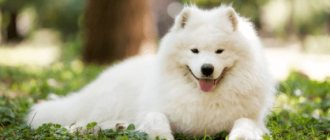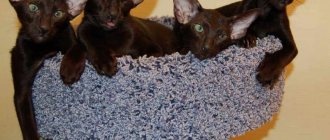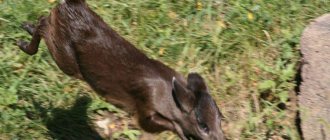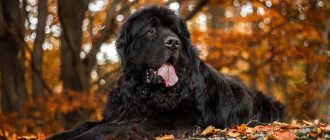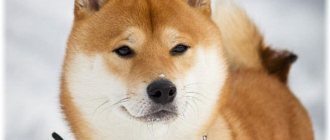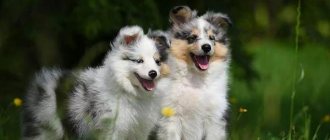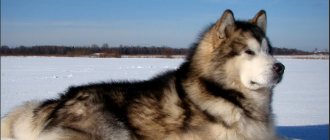Origin of the breed
Looking at Shelties, it may seem that they are decorative dogs. But, in fact, this is absolutely not true - this breed of Scottish Shepherd was once used for herding livestock. By the way, this is the smallest herding breed in the world. It was used for small herds, but when the number of livestock increased, they were replaced by other, larger and hardier herding dogs. The breed was saved from extinction by Sheltie lovers who engaged in breeding work, which had a positive effect on the appearance of these animals.
As for the origin, not everything is clear. Experts agree on one thing - the Sheltie's ancestors are Scandinavian dogs that look like Spitz dogs, and herding breeds from Iceland. At the very beginning, dogs were valued more for their working qualities than their appearance. But dog handlers paid attention to this aspect, and as a result, the pets acquired the appearance characteristic of modern Shelties.
If we consider the resemblance to a collie, then, most likely, the determining factor is one habitat rather than family ties. Crossbreeding was present, but the main material was not longhairs, but border collies.
Story
If you look at the map, you can see the Shetland Islands in the northeast of Scotland. In ancient times, the aboriginal, extinct "Yakki" dogs lived there. Most likely, they formed the basis of the Sheltie breed. According to experts, the Norwegian Buhund and the short Laika from Greenland also participated in its appearance.
Unfortunately, not a single documentary evidence of the true origin of the Sheltie has survived . It is possible that she is as old as the world, and her original name sounded like “dog tuni” (translated from the ancient Gaelic language as “farm dog”).
The small and agile ancestors of the Sheltie herded small sheep, which practically do not exist in our time. The islands of their habitat were protected by a water boundary from predatory animals, and therefore there was no need to protect flocks of sheep from wolves.
Since that time, a lot has changed, the sheep became larger and larger and more vicious dogs were needed to herd and guard them. The need for a miniature Sheltie disappeared by itself and as a result, she could completely disappear from the face of the earth.
Fortunately, Sheltie quickly found herself in a different role. She became a companion dog and human companion. The breed was stabilized and improved by infusing it with the blood of the Scottish Shepherd Collie, brought to the Shetland Islands from Great Britain.
During her formative years, the cutie Sheltie underwent many “design” decisions. They tried to breed her with Spitz and Papillon, and they mixed her with Border Collie and King Charles Spaniel genes. Until the beginning of the 20th century, her family tree was in complete disarray.
In 1914, thanks to breed lovers, an active struggle began to restore the purebred Sheltie line, which lasted until 1947. The fundamental breed standard was adopted in 1948, and further adjustments were made to it in 1987. In this form, the unique Sheltie has survived to this day.
Description of the Sheltie breed
Small, but not dwarf (ideal height for males is 37 cm, for females 35.5 cm). Long-haired, but not a shaggy “ball of hair.” Strong, well muscled, but not clumsy. Slightly stretched format. The dog has the breed's sweet expression on its face, giving an overall impression of elegance, but without sophistication.
Head, with a flat skull and cheeks, tapering evenly from the ears to the tip of the nose. The transition from forehead to muzzle should be slight but clearly defined. The bite is only scissor bite with a full set of teeth.
Strong, symmetrical jaws with dense lips. Medium size, proportional to the muzzle, very expressive almond-shaped eyes set obliquely. The color is dark brown, with the exception of representatives of the merle color.
In this case, a blue color is acceptable, with possible brown veins. The small, closely spaced, semi-erect ears have slightly forward-curved tips.
Since this is a working dog, the standard very clearly stipulates what the quality of the dog’s coat should be. The spine is straight, of good length, hard to the touch.
Coat and colors
Wool is the main decoration for a Sheltie dog. Her luxurious fur coat has a rich and dense undercoat. It supports the long and heavy spine in an almost vertical position.
A recognizable feature of the Sheltie breed is a voluminous “lion’s mane” and a lush collar area. The outer hair on the body is coarse and as straight as possible. The riding breeches and tail area have the longest hair and elegant fringes. The hair on the face and paws is short and dense.
Acceptable colors
- Tricolor (black and tan with white markings);
- Sable (a combination of red, red, gold and white);
- Two-color (black and white);
- B-merle (white with silver flecks and black stripes);
- Blue Merle (silver-blue color and black specks);
- Marble.
Sheltie's vices
- liquid and soft wool;
- thinness;
- obesity;
- Round eyes;
- hanging or erect ears;
- short and blunt muzzle;
- malocclusion;
- ring tail;
- short and disproportionate legs.
CHARACTER
The reputation of an excellent companion dog is well deserved; Shelties are very smart, playful, easy to train and love their owners. They are famous for their loyalty, but they are wary of strangers. With sufficient socialization, this can be corrected, especially if it starts at an early age.
Since these are herding dogs, their behavior is characteristic. They are active, love to look after and manage, are smart and are able to make independent decisions. If you do not give an outlet for energy, the dog will become bored and this will lead to destructive behavior or barking. Fortunately, with regular walks, games and activity, the dog is a completely calm and peaceful dog.
Considering that she is active and smart, there are a lot of ways to keep her busy. This includes agility and offense, frisbee, training of various types. In general, everything is limited only by the owner’s imagination.
The author of the book “Dog Intelligence,” Stanley Coren, considers the Sheltie one of the smartest dog breeds, ranking 6th among all the breeds studied (and there are 132 of them). She learns a command in 5 repetitions, and executes it 95% or more of the time. Naturally, with such data, training her is a pleasant and exciting task.
As for relationships with children, the Sheltie loves children and playing with them. But, as with any breed, playtime needs to be supervised to ensure the dog doesn't end up in a situation where he needs to defend himself.
How much does it cost and where to buy
Sheltie is a fairly common breed of dog, so choosing a kennel will not be difficult. You should not buy a puppy from your own hands: this is fraught with genetic diseases and behavioral disorders. The breeder guarantees initial social skills and is ready to provide full information about the puppy’s pedigree.
List of nurseries:
- Russian Versailles (Moscow);
- Great Vizedry (Moscow);
- Watercolor Fantasy (Izhevsk);
- Sun Empire (Barnaul);
- From the Princely Family (Kovrov);
- Julia Style (Samara);
- Iris Blue (Petrozavodsk);
- Aleander (Novosibirsk);
- From the Tver Fairy Tale (Tver);
- Silvent line (Tambov);
- Jetston (St. Petersburg).
Average cost: 23,000-45,000 rubles.
How is a Sheltie different from a Collie?
Sheltie and collie are two separate breeds. Their external similarity is explained by the presence of common ancestors - Scottish cattle dogs. The height of a collie reaches 61 cm, a sheltie – 39 cm. A sheltie has a rich palette of colors: it has 5 species. Collies have only 3 of them. Both breeds are known for their increased intelligence. They get along with children and are not prone to suppressing their owners. At the same time, dogs are capable of making independent decisions. Physical violence is unacceptable to them.
Collies have a reserved temperament. Shelties are perpetual motion machines. They are suitable for active, energetic owners. Collies will make good companions for older and calm people. Both breeds are not suitable for the role of watchdogs. The Sheltie has the makings of a protector. At the same time, she is prone to barking for no reason. For those who prefer silent dogs, it is better to get a collie.
Sheltie or Aussie: who is better?
Aussies and Shetlanders are herding breeds. Aussies are distinguished by their large size (height up to 58 cm) and a pronounced guard instinct. They are stubborn and independent and must always be on the job. Aussies are great companions, but they can't sit still. They tend to demonstrate shepherd instincts even in the apartment, controlling the household. At the same time, they get along well with children. Shelties are more like a moving top. She is not prone to dominant behavior and adore her owners. These dogs do not like to be left alone and need constant attention.
Aussie is not a decorative pet, but a representative of a working breed. He needs space and constant employment. If a person needs a guard dog that can also be a companion, this option is for him.
Choosing a pet is a subjective thing. Connoisseurs of a certain breed turn even shortcomings into features. Therefore, it is better to rely on your own judgment.
Breed standard
- The head is thin, wedge-shaped and neatly blunt, not too light. The back of the head is not pronounced, the forehead is flat, moderately wide. The transition from forehead to muzzle is not sharp, but can be easily felt. The lines of the forehead and muzzle are strictly parallel, the back of the nose is straight. The brow ridges are not prominent. The cheekbones and chewing muscles are developed and blend smoothly into the silhouette of the muzzle. The chin is U-shaped, the lips are tight-fitting, “dry”.
- Teeth – in full set and correct bite and in accordance with the dental formula. The incisors are equal in size, set vertically and parallel. The jaws are fully developed, deep, strong.
- The nose is proportional, small, black.
- The eyes are almond-shaped, expressive, set at a slight angle. The eyelids are tight-fitting and pigmented. The eye color is rich, brown, although with blue merle color blue eyes and black spots on the iris are allowed. When assessing, an important role is played by the gaze, the expression of which is determined by a combination of three factors: the position of the ears, the color of the irises and the shape of the eyes. When viewed, the dog should appear friendly or alert, without a hint of fear or hesitation.
- The ears are small, triangular, very mobile. The tips are curved 1/3 of the length of the ear, directed forward. When at rest, the ears are laid back on the mane, when the dog is focused, turned forward and slightly tilted.
- The body is harmoniously built, the body is not too squat. The neck is high, with a noticeable bend, and muscular. The withers are weakly expressed, the shoulder blades are inclined, emphasizing the width of the chest. The chest is spacious, deep and wide, narrowed downwards. The back line is even, the loin is slightly raised and well muscled, the croup is not too long, sloping. The groin line is moderately tucked.
- The limbs are smooth, quite strong, the shoulder blades and shoulders articulate at right angles. The forelimbs are almost vertical, the elbows are strong, directed backwards. The hind limbs are more muscular. The angles of the hip joints are straight, the shins are elongated, the hocks are dry but strong, the metatarsals are steep. The hands are rounded, the fingers are tightly clenched and tucked. The pads are very strong, a little rough, the claws are strong, not too long, arched.
- The tail is richly furred, of standard length, carried freely down or at the level of the back. A crescent shape is acceptable. The tail should not curl over the back.
Advantages and disadvantages
Like any other breed, the Sheltie has a number of pros and cons. Each breeder decides what is more important to him and what he can fight or put up with. We present them more clearly.
| Pros of Sheltie | Cons of Sheltie |
| Goodwill | Lack of security qualities |
| Lack of aggression | Barks and howls alone |
| High intelligence | Sensual and vulnerable nature |
| Physical activity | Poor health, low immunity. |
| Stability and mobility of the nervous system | Fear of the unknown |
| Devotion | Timidity and shyness |
| Friendship and getting along with representatives of fauna | Painful reaction to criticism |
Education and training
Training a Sheltie is a fairly simple task. Both the owner and the pet enjoy the process. The intelligence and obedience of dogs allows this task to be entrusted even to children. But for comfortable training, a number of nuances should be taken into account. For example, rudeness and physical violence are unacceptable when communicating with a pet. The basis of fruitful interaction is gentle persuasion and verbal praise.
Shelties are able to understand a command the first time and execute it perfectly the second time. However, it is important not to forget about securing the material. Given their timidity, training should begin without the presence of external stimuli, gradually including them. You can use various methods of attracting attention - toys, treats, affection. A positive-minded animal is unlikely to refuse to follow commands, of course, if it is completely healthy.
If the dog begins to “indulge”, then you should not immediately apply punishment; it is enough to ignore these manifestations, and the dog will quickly understand that with such behavior he will not see any reward. Sheltie puppies are quite active in exploring their surroundings and often show their teeth. You can’t let it go so easily, but you shouldn’t physically influence it either. In this case, it will be enough to spoil the pet’s pleasure, for example, by spraying a special product on the chewed object.
Health and illness
The breed is considered relatively healthy. She hasn’t had time to accumulate many errors in her gene pool, so she is prone to only a few diseases:
- Hip dysplasia. A rare breed boasts a lack of predisposition to this disease. It usually appears suddenly for the owner: the dog suddenly begins to limp and complain of severe pain. It can be treated, but it will require money and time.
- Problems with the thyroid gland. As a rule, hypersecretion of hormones, which leads to changes in the dog’s character - and not for the better. She becomes disobedient, capricious, even aggressive. To compensate for this, you will have to give your pet medications designed specifically for such cases throughout his life.
- Obesity. Like most working dogs, they easily overeat and do not know how to stop - this is due to the fact that their ancestors rarely ate their fill. The owner's job is to ensure that the pet receives exactly the right amount of nutrients and calories for its activity level, and no more.
- Allergy. Not food, but due to medications occurs quite often. Therefore, before treating your pet, you need to make sure that an allergic reaction does not occur.
With proper prevention, not excessive feeding and adequate care, Shelties live on average 15 years - for a medium-sized breed this is a good indicator. And the less the dog is nervous, sick and bored, the greater the chance that he will live even longer.
Pet care
The main care is attention to the dog’s coat. She should be brushed and bathed regularly. It is advisable to have several special combs and brushes:
- metal with rare teeth;
- metal with fine teeth;
- massage;
- a brush with bristles;
- slicker for long hair.
You will have to thoroughly comb your dog 2-3 times a month, and during periods of seasonal shedding much more often - daily. Otherwise, dense tangles will begin to form on the fur. But you should not wash your dog so often, once every 1-2 months is enough. It is recommended to use special products, but do not apply them pure to the coat, but dilute them with water and pour or spray them on the coat.
If we talk about the health of Shelties, living in a harsh climate has made them very strong. They live for about 20 years and remain very charismatic almost all the time. Regular examination and cleaning of the ears and eyes is also necessary. For dental health, it is enough to regularly give your pet large bones or special treats that can be purchased at a pet store.
Collie and Sheltie - similarities and differences
As mentioned above, the older Collie brothers participated in the improvement of the Sheltie, but calling the Sheltie a “mini Collie” or its “clone” is fundamentally correct. Undoubtedly, both breeds are similar in their high intelligence, muzzle shape, colors and coat, and this cannot be denied. When examined in detail, they have actual differences.
Difference table
| Comparative parameters | Sheltie | Collie |
| FCI standard | № 88 | № 156 |
| Maximum height at withers | 37 cm | 61 cm |
| Activity | Moderate | Strong |
| Security qualities | None | Average |
| Health and immunity | Weak | Good |
Sheltie and Collie are related, but not the same breeds. They have visual similarities, but their ancestors were dogs living in different territories in different time periods.
A distinctive feature for collies and shelties is that when trotting, they keep their heads slightly down, and not upright, like most dogs.
And one more important factor. If among the Scottish Sheepdogs Collie there is a variety of Border Collie, that is, short-haired, then among the Shelties such a variety does not exist.
If someone convinces you that the puppy is a rare breed of mini Sheltie, then most likely this is a scammer who is trying to sell you a wonderful mongrel, but for a large sum of money.
Tips for choosing a puppy
In recent years, Sheltie puppies have become a very popular “commodity”, but with fame, the risks of deception have also increased. We are talking about non-pedigreed dogs that are passed off as purebreds for profit. If you are open-minded about the breed, there are thousands of dogs in shelters waiting for you, but if you are going to spend the money, you should get “quality.”
We recommend that you choose a Sheltie puppy from a kennel whose activities are controlled by large canine organizations. You may be confused by the price, but kennels also sell pet-class puppies (not for exhibitions). When buying a pet from a breeder, you can count on a stable psyche and good health of the ward... when buying a puppy from your own hands, you get a “pig in a poke.”
Purebred puppies have a package of documents, the so-called puppy certificate, and a veterinary passport. In addition, Shelties are prone to a number of hereditary diseases , for which producers are screened. For example, the gene for dwarfism or eye abnormality in collies is transmitted exclusively by inheritance.
Be vigilant and treat the purchase of a puppy with all the composure that you are capable of. If you have no experience, ask for help! Almost every kennel club has breed experts who (for a fee) will help you weed out dubious options.
Note! Raising and raising a puppy of any breed requires specific knowledge and experience, and reputable breeders are always ready to help the new owner.
Training and physical activity
Shelties are distinguished by enviable intelligence, like true shepherds, they are able to independently assess the situation and make decisions. They are remarkably trainable and have quick reactions. During the training process, you should use only gentle persuasion, verbal praise and treats. You cannot be rude and cruel, otherwise traits such as anger, stubbornness, and deliberate disobedience will begin to appear in your character. If you do not pay attention to the socialization of the puppy, in adulthood the Sheltie can be timid and fearful.
The Sheltie needs regular walking and mental stimulation. The dog will be happy with any type of activity, from a regular game of balls or Frisbee to professional sports (agility, freestyle, etc.) The best option would be a two-time walk lasting more than 30 minutes. During walks, it is necessary to give the dog the opportunity and motivation to move. Exercising will help the Sheltie maintain good health and excellent physical shape.
How to feed a Sheltie
As is the case with other breeds, Sheltie can be fed both natural food and industrial feed. In the second case, you should choose premium and super-premium diets from lines suitable for small breeds.
If the owner decides to feed the dog “natural” food, then 50% of the diet should consist of meat products - beef, veal, turkey, rabbit, lean lamb and offal. Pork and liver are undesirable. The meat is given raw, previously scalded with boiling water; the offal must be boiled.
Porridges are also good for dogs - rice, buckwheat, oatmeal are well boiled in broths - meat, fish, vegetables. It is recommended to season the dish with vegetable oil, and also add chopped fresh herbs - a source of vitamins. Shelties must be given fresh chicken or quail yolks - 2-3 times a week, but both yolk and white can be given boiled.
In general, shelties love to eat, so you can give them fresh fruits, berries, and vegetables, which most of these pets eat with pleasure. You can also cook vegetable stew and other dishes. Milk is not recommended for adult dogs, but fermented milk products must be present in the diet. Dried fruits can be an excellent treat for Shelties. Considering the cute appearance of dogs, it is worth excluding situations when they are treated from the table, if not by the owners themselves, then by “compassionate” guests.
Some interesting facts
- Most Shelties are active dogs. They have a shrill voice. To maintain friendly relations with neighbors, you need to train your dog from an early age. The pet must understand when to bark and when not to.
- Be prepared for Sheltie to actively shed twice a year: in the spring and at any other time of the year (everything will depend on the characteristics of the particular dog).
- Shelties are extremely intelligent. They require quite a lot of exercise. However, sometimes they can be stubborn. This happens when the pet is bored. All exercises should be interesting not for the owner, but for the dog.
- Shelties are full of energy. They love active exercises that are combined with intellectual ones.
- Due to the fact that dogs of this breed have been very popular over the years, a bad situation has developed with Sheltie breeding. You should not buy a puppy from random breeders, they may suffer from various genetic diseases. It is best to make a purchase from a trusted dog breeder. In this case, you will be confident that the puppy is healthy and will develop normally.
Price
Nowadays, Sheltie can be bought throughout the country; the days when this breed was considered rare have already passed. The small, swift, fluffy light has firmly won many hearts.
If you type “ sheltie reviews ” into a search engine, you get the impression of an ideal dog with no flaws. Unfortunately, this is not true.
And for some, both the activity and talkativeness of the dog becomes a big minus. This is why it is so important to communicate with adult representatives of this breed. And then the purchase will not turn into disappointment.
In general, take your time with the purchase. After all, the Sheltie, the price of which consists of many nuances, is a fairly popular breed. A good pedigree puppy can be purchased from 15 thousand rubles. Look at the nurseries, decide on the color, get to know the kids. Perhaps your Sheltie has just been born.
How to choose a puppy
If a person has decided that he will get one as a pet, then first he needs to prepare the house for the arrival of a Sheltie puppy. There are some recommendations for this:
- hide valuables (shoes, papers, valuables);
- hide small objects (the puppy may swallow a dangerous object);
- remove wires, cords, and cables from sight;
- prepare toys for the puppy so that he does not harm things;
- the floor surface should not be slippery so that the puppy does not get injured;
- It is necessary to prepare a place for the dog to feed and sleep.
When purchasing a puppy, you should give preference to experienced breeders or a nursery. If a pedigree is provided, this provides a guarantee that the dog is purebred and also has no health problems.
When choosing a puppy, you should pay attention to the following points:
- the puppy looks healthy and playful in appearance;
- eyes and ears are clean;
- the color matches the description of the standard, there are no additional shades or impurities;
- weight of a 1.5-2 month old puppy – from 1.2 to 2 kg;
- The dog's physique is strong, its body features are symmetrical, its limbs are straight;
- There is no lameness when walking.
You can ask the breeder to show the puppy's parents to see what it will ultimately become.
The Shetland Sheepdog is not one of the commercial breeds; Sheltie breeding is carried out by lovers of pure genetics and breed standards. This affects not only the quality of the offspring, but also the cost of the dog.
You can buy a Sheltie puppy from a professional breeder for 30-35 thousand rubles, taking into account the fact that there is a pedigree and the parents are show dogs. If the dog is not purchased for exhibitions, then its cost will be 15-20 thousand rubles.
Interesting fact! Males look more beautiful in appearance than females, but the price for a male is much less.
When purchasing a Sheltie, you should know that this dog needs proper care and maintenance. Wool requires special care, but if it is provided, there will be no problems. You don't need any skills to become friends with a Shetland Sheepdog. It is enough to instill in her basic rules of behavior and go for walks more often. This breed of dog is devoted to its owner in everything, so if you give it love and care, it will reciprocate.
Reviews
Olga
Sheltie is the perfect dog. Not big, beautiful, very smart, humane, not confrontational at all, caring. A Sheltie will never destroy a house. She is intelligent. Gentle, kind, cheerful and unobtrusive. He really barks a lot. Shelties bark to indicate an enemy. This is what they were created for. Doesn't bark at all at home. Only for dogs and crows. Moreover, it refers only to birds of prey. She is not interested in pigeons and other city birds. Shelties can be trusted with small flocks of geese, chickens, ducks, and neither a fox nor a hawk will sneak up on them. This is the only breed that means “air”. Trained in two or three repetitions of the command. Very athletic. With her, either to the forest or to the city. They don't shed. Sometimes you have to scratch. The best breed.
Aytalina
I got my Sheltie completely by accident. Before him, I had a cat who died tragically, after that I promised myself not to have any more animals, especially dogs, since you need to walk with them, devote time, and even fur, which constantly sticks to clothes, after which you walk around like you’ve been swallowed chick. And so, 3-4 years later, I went to visit my brother for an overnight stay and the next day when I returned from work, I saw that they had a new family member of the Sheltie breed. And from that day, in the evenings for 3-4 days, I began to walk with him until I returned home. Afterwards, when I went to visit them, the dog was so happy about my return (and during the 2 years he lived with them, I returned at least 5 times, probably, and then only for a couple of hours). Then, one fine summer weekend, out of the blue, I went to a local classifieds website and chose the animal sales category, although before that I had always gone in, I’ll give it away for free))) (and for a minute, I haven’t visited this site for probably 5 years or so more) and what do you think, already on the third ad I see that a dog I know is sitting. So I went inside this ad and in the third of four photographs I see a familiar leash, on a dog I know. I immediately wrote to my daughter-in-law and asked if they were selling their dog, but as it turned out, due to the fact that the dog was constantly doing his business, big and small, on the bed or somewhere in the apartment, they simply returned him back to the breeder. Without hesitation, without telling anyone in the household, I wrote to the number indicated and after long negotiations over several days, it ended up in my apartment.
Now he and I have been living in perfect harmony for several years. Household members adore him from head to tail. Due to the fact that the dog knew me before, he immediately wedged himself into our pack; he never did his bad deeds, which he had done before in his previous family, moreover, if he feels the need, even if the owner dies there and even if he is already half at night I sleep in my bed, he will wake me up and drag me outside to do my business.
A very affectionate, active, intelligent breed. Even if the dog is already an adult, do not be afraid to take him into a loving family, thereby dooming another frightened but big heart to love you more than life itself to a happy life. And it doesn’t matter whether it is purebred or not, because animals feel your love and will thank you by making your life bright and happy.
We are already the fourth family for our dog, who took him in when he was already 4 years old. And there is no more faithful and grateful soul in this world like our Pie. We love him very much and thank God for the fact that he once united our destinies.
lenaguseva
Advantages:
- Good
- smart
Flaws:
- Barks a lot
My shelta is very kind to people, do what you want with her) but she barks very much at unfamiliar dogs, although she herself is very afraid of them, it’s impossible to go outside - barking immediately starts as soon as she sees someone))
In my opinion, this is not the most active breed, although it seems to me that it’s still possible that our dog just got lazy.)
vikysha-9292
Advantages:
- Smart
- friendly
- loves children
- active
- beautiful
- not intrusive
Flaws:
- No
I dreamed of a Sheltie since childhood. and when she finally appeared in my family I was not at all disappointed. wonderful dog, incredibly beautiful (get ready for constant attention on the street). Very active, but only on the street, does not cause pogroms at home. Loves attention, but at the same time is not intrusive. Friendly, absolutely not aggressive, loves everyone: people, dogs, cats, hamsters... gets along well with any animal. An ideal dog for a family with children, he loves children very much, such a nanny dog. She is not shy, but she treats strangers with caution, which in my opinion is a plus. As for barking, he will never bark idlely; usually when he calls, he warns that a stranger is approaching. but even this, if desired, can be cut right away. Despite the luxurious wool, it does not require any special care. It is enough to comb behind the ears once a week (where tangles can form), and once a month to completely comb. wash even less often, not counting washing paws after a walk. Shelties are smart dogs that catch all commands on the fly. They are in the top 6 among all breeds in terms of intelligence. In general, in my opinion, you cannot find a more ideal dog for a family.
Anonymous265100
Advantages:
- One hundred pluses
Flaws:
- No
My Millie (WHITE SEABORD PIKADILLI) is just a sweet daughter! Until I took it, I didn’t know that I loved it! This is a creature that really loves you, not for money, etc., but because it simply loves you for what you are! I recommend it to everyone! want to become kinder? start this miracle! By the way, she became friends with three of my cats in five minutes and is already chasing them! I mean, he forces them to play with their own mice! Wow!
